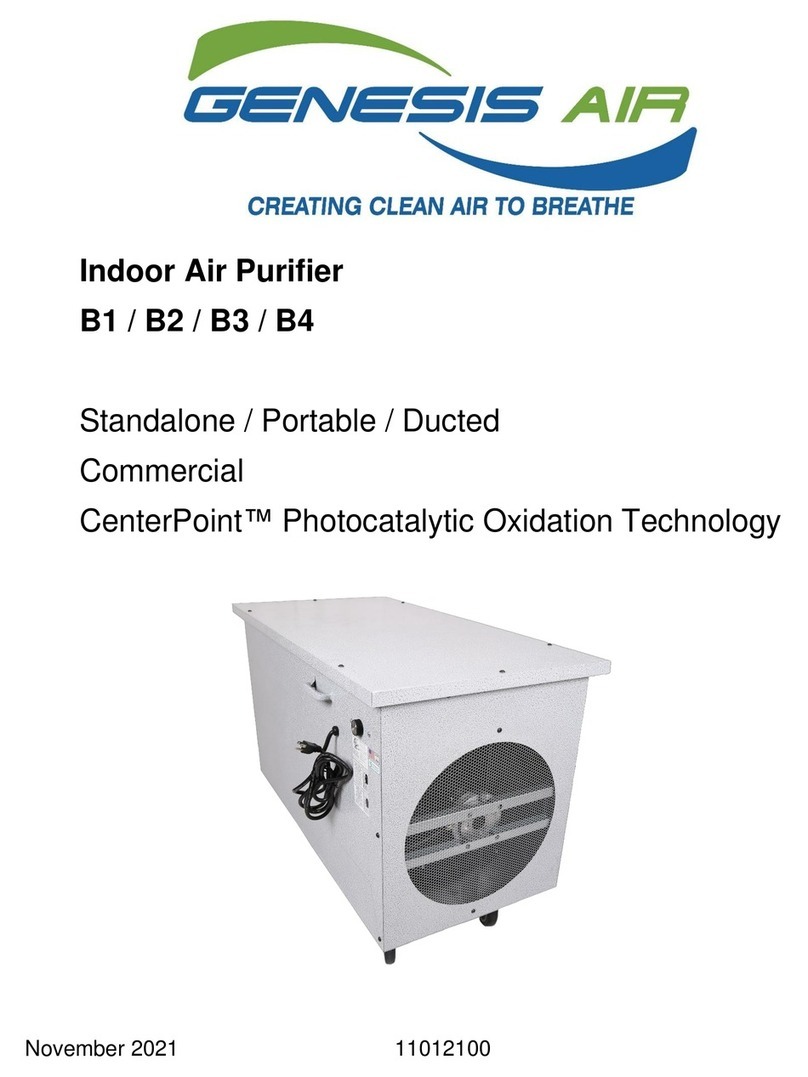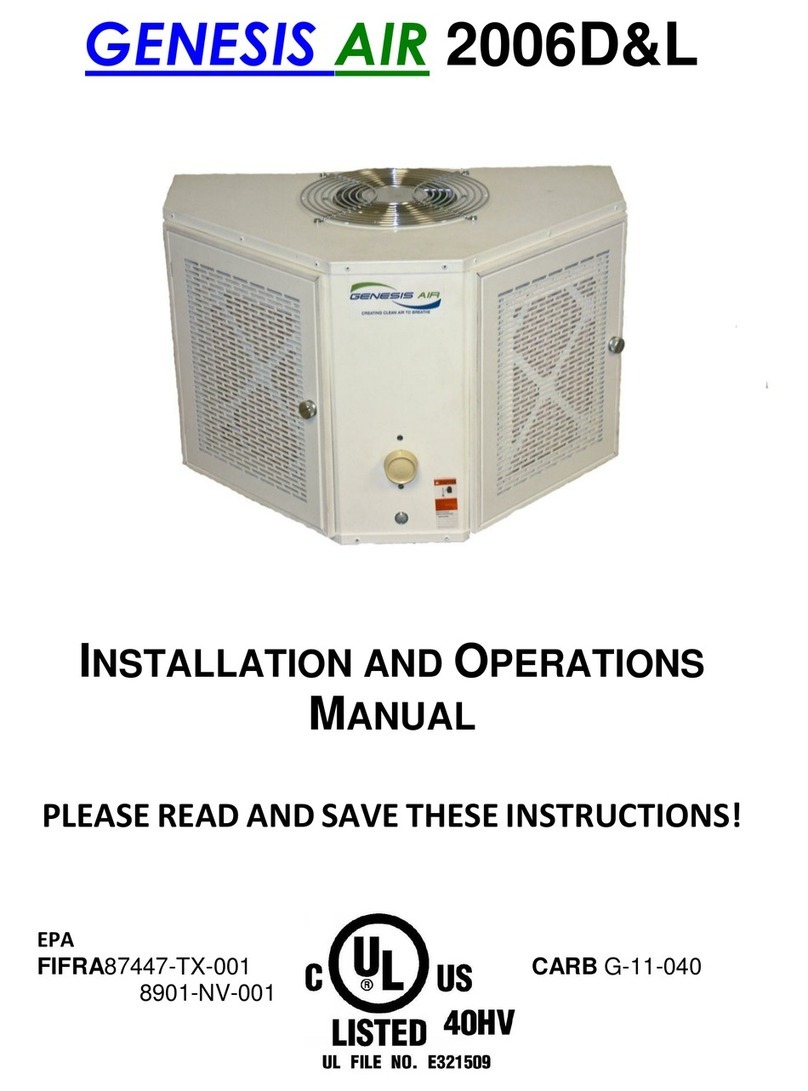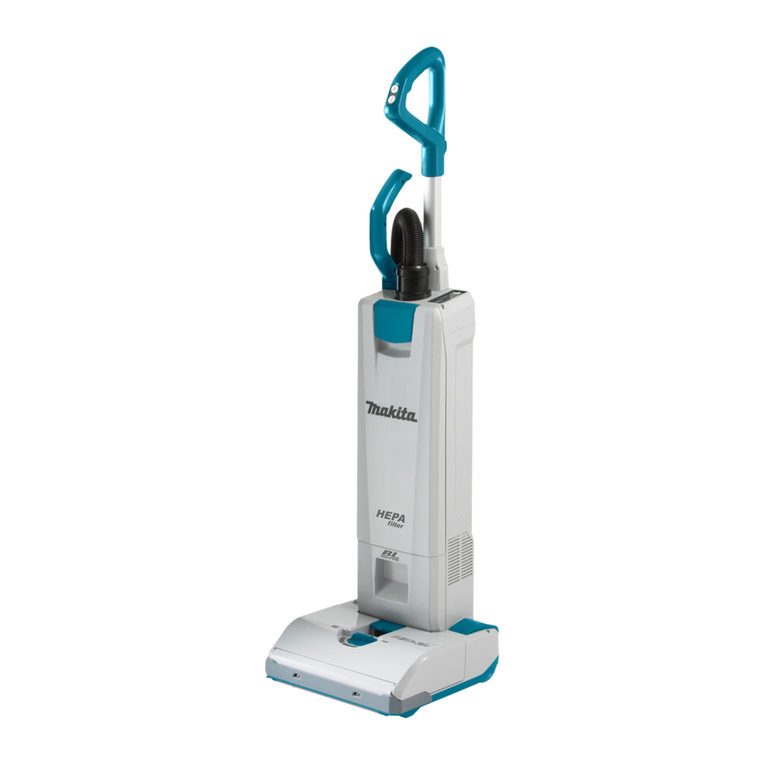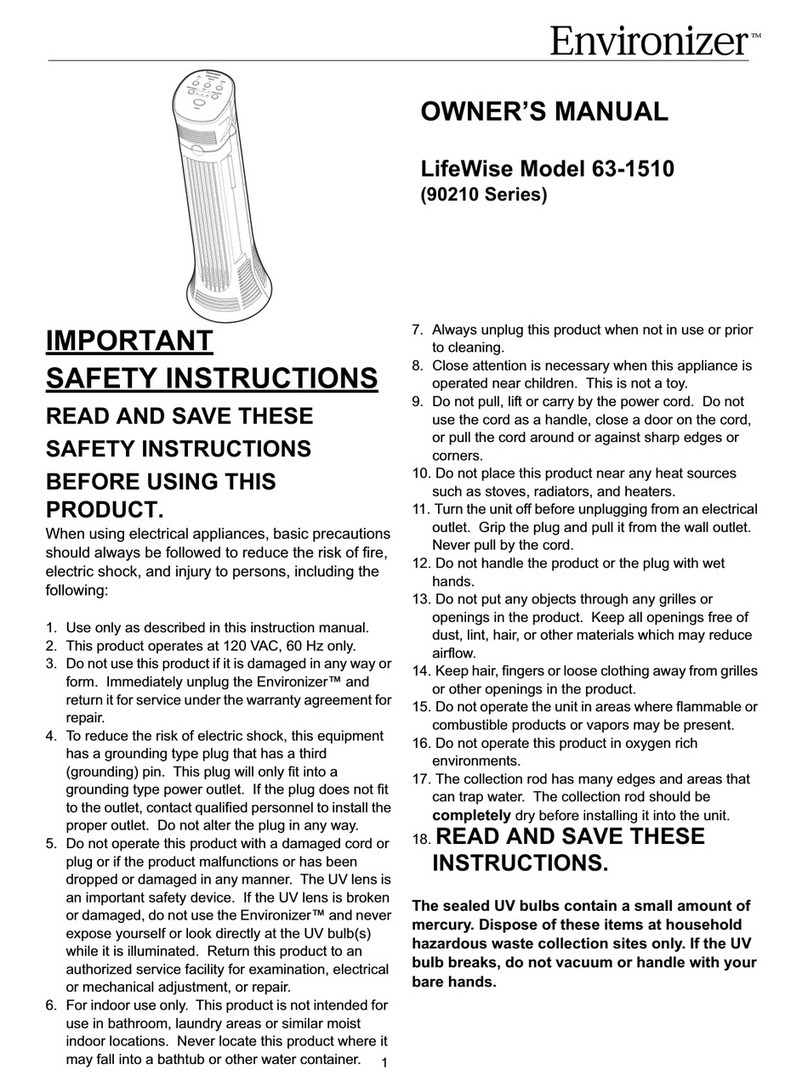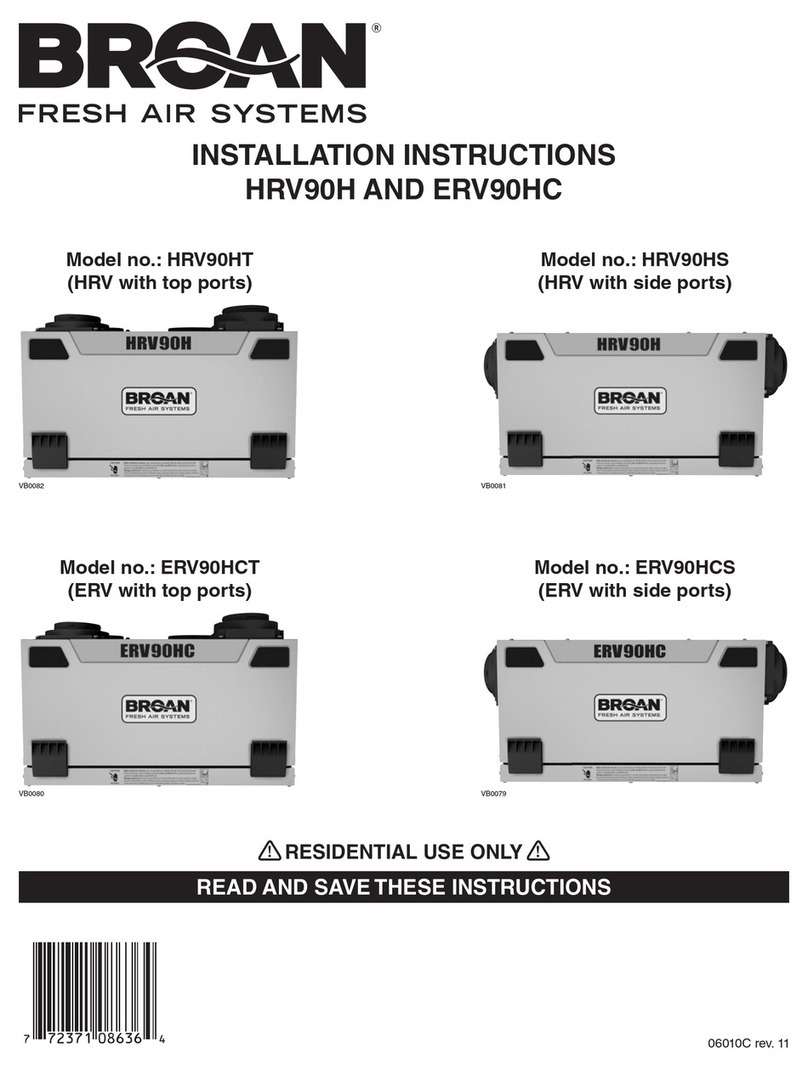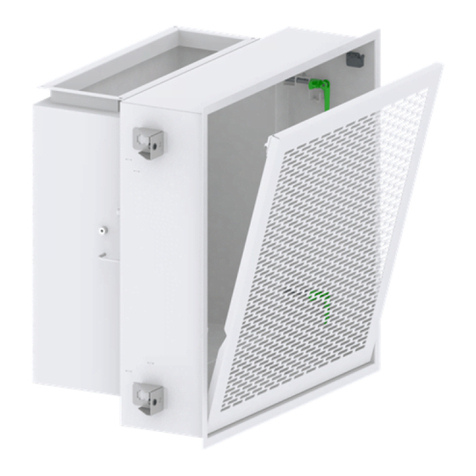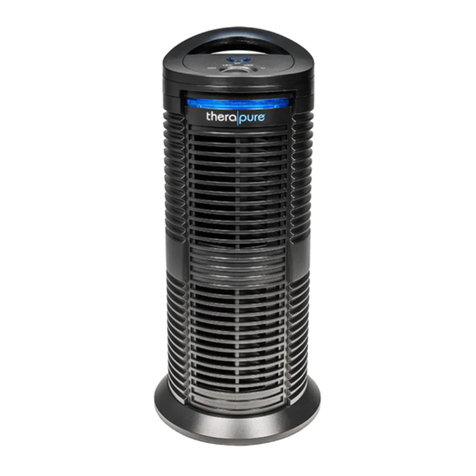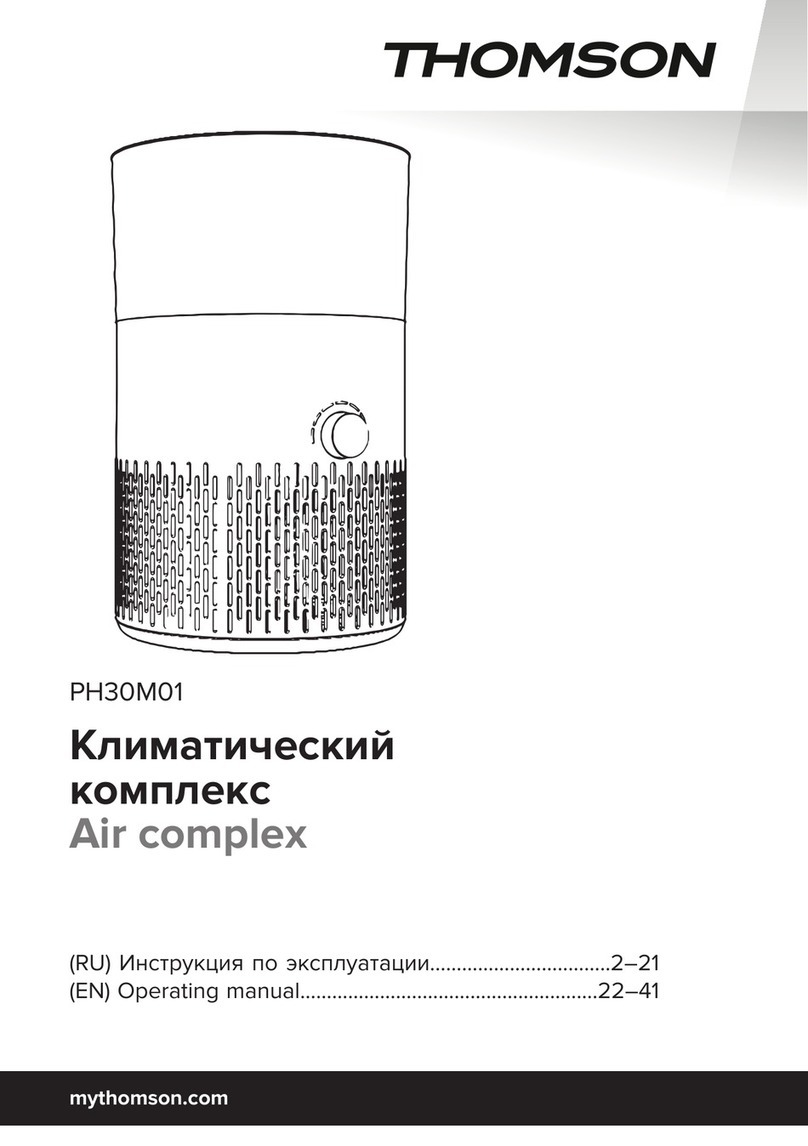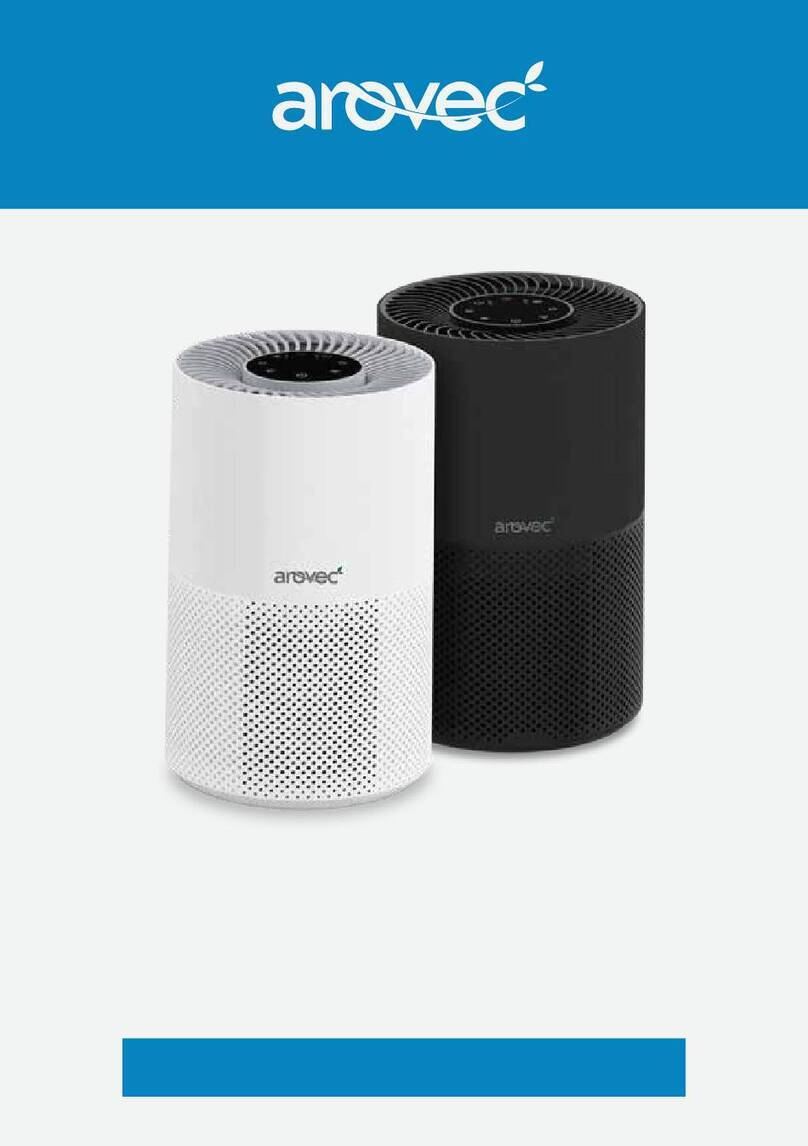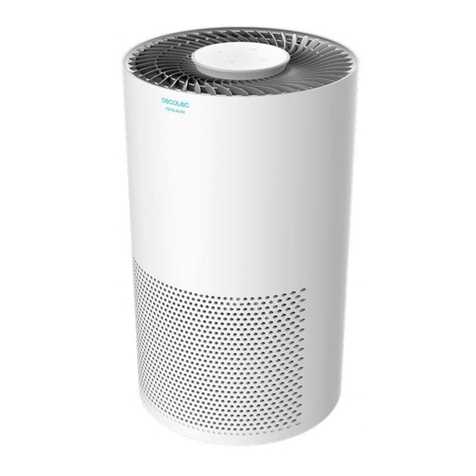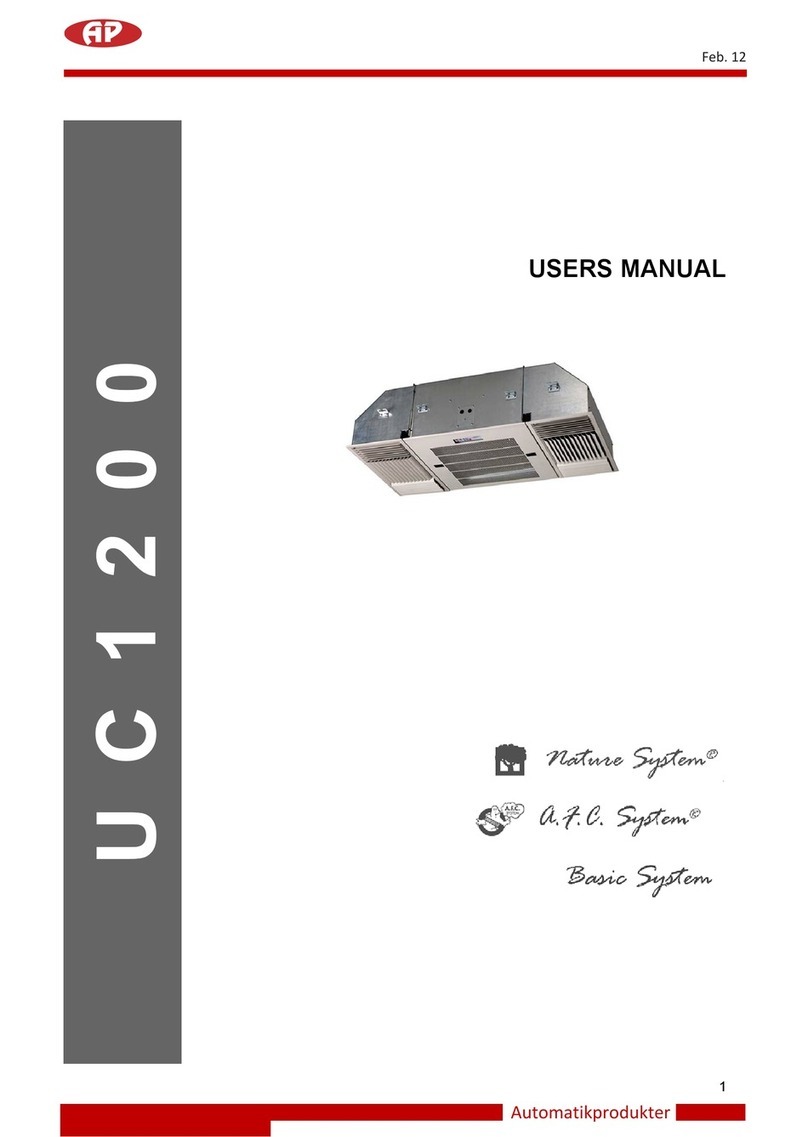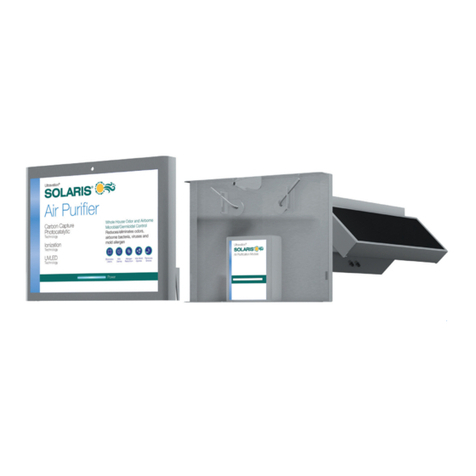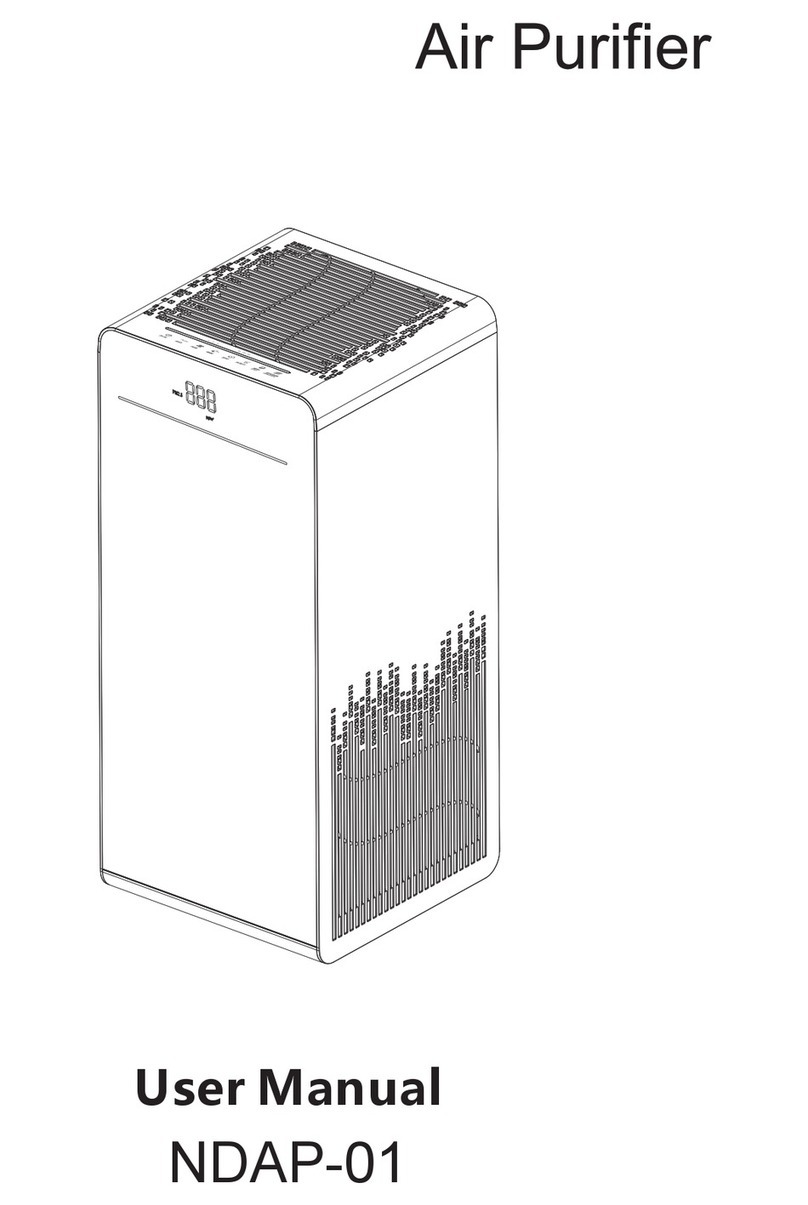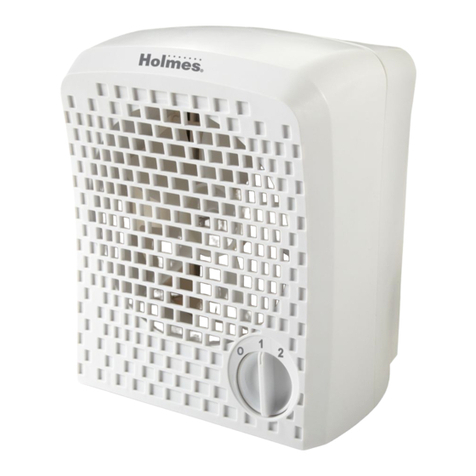Genesis Air 2008 DT-FP User manual

Indoor Air Purifiers
2008 DT-FP
Standalone / Ducted
Commercial / Residential
CenterPoint™Photocatalytic Oxidation Technology
November 2021 11012100

2
Product Description
The DT-FP unit is a stand-alone unit used to reduce the levels of Volatile Organic Compounds
(VOC’s) and viable airborne biological contaminants. The unit is intended to be permanently ducted
into a building. The DT-FP uses (1) 1620 Populated Catalyst Panel. The DT-FP is suitable for spaces
between 700 and 2400 square feet. For recommend configurations, consult with the manufacturer’s
engineering department. The DT-FP incorporates 3-step GAP™Technology: MERV Filtration, UVGI
Lamps, and Photocatalyst.
*Refer to page 8 for performance at different room sizes.
Shipping and Packing List
Standard Equipment:
(1) DT-FP Housing
(1) 1620 CU-S Housing
(1) 1620 PCP
(1) 20” x 20” x 4” MERV 13 Particle Filter
Features:
•Variable Speed Control
Optional Equipment:
•20” x 20” x 4” Return Filter Grille
•Supply Grille
Copyright
Genesis Air, Inc. is the owner of this document and the information it contains. The manufacturer
reserves the right to revise this publication at any time and make changes to its content without
obligation to notify any person of such revision or change.
Revision Summary
Original IOM manual create in November 2019.
Current manual last revised on November 1st, 2021.

3
Table of Contents
Product Description 2
Shipping and Packing List 2
Copyright 2
Revisions Summary 2
Safety Certifications 4
Warning Labels 5 –6
Product Overview 7
Specifications 8
Product Labeling Nomenclature 8
UV Lamp Safety Information 9
Installation 10 –12
Operation 13 –14
Air Changes Per Hour 14
Maintenance 15 –26
Filter Replacement 15
Lamp Replacement 16 –18
Lamp Disposal 18 –19
Ballast Troubleshooting 20
Ballast Replacement 21 –22
Fan Motor Replacement 23 –25
Catalyst Cleaning 26 –27
Replacement Parts 28
Wiring Diagram 29
Fan Diagram 30
Air Purification Testing 31
Warranty 32 –33

4
Safety Certifications
UL Classified UL File No. E326567
FIFRA….EPA EST No. 87747--TX--001
UL Requirements
•105°C minimum supply connection rating.
•For catalyst marked “XXXX”, 50°C/122°F maximum ambient temperature. For those marked
“XXXX-E”, 80°C/176°F maximum ambient temperature.
•Suitable for air-handling units
•Access above ceiling may be required.
•The health aspects associated with the use of this product and its ability to aid in disinfection of
environment air have not been investigated by UL.
•Only use type T5 lamps specified by the catalyst panel manufactured by First Light
Technologies, Inc or UV Engineering Solutions LLC.
•Caution: Equipment Damage Hazard. Ultraviolet light can cause color shift or surface
degradation and sometimes structural degradation of non-metallic components. Select
mounting location rubber hoses, wiring insulation, filtration media, etc. If mounting options are
limited, items above should be protected with ultraviolet resistant materials such as aluminum
foil, aluminum duct tape or metallic shields.
CARB Certified Air Cleaning Device….EO No. G-11-040

5
Applicable Warning Labels
To reduce the potential of electric shock or
fire, the wiring required by this manual should
be performed by a licensed electrician in
accordance with applicable National Electric
Cod, NFPA 70, and local codes.
Electric / Shock Hazard
Electrical Shock can cause
serious injury or death.
Disconnect all remote
electrical power supplies
before servicing.
To reduce the potential of electric shock or
fire, the wiring required by this manual
should be performed by a licensed electrician
in accordance with applicable National
Electric Cod, NFPA 70, and local codes.
UVC Light hazard. UVC light can cause temporary or permanent loss of vision
and sunburn. Take proper precautions to protect eyes and skin from direct
exposure. Replace lamp with Model No. 2813, Manufactured by First Light
Technologies, Inc., or lamp with Model No. GEN9093, Manufactured by UV
Engineering Solutions LLC.
Mercury Hazard
Do not break lamps. Each UVC lamp contains
a small amount of Mercury. In case of
breakage use proper lamp disposal techniques
on page 13.
Improper installation, adjustment, alteration,
service, or maintenance can cause property
damage, personal injury, or death. Installation
and service must be performed by a qualified
installer or service agency.
TO REDUCE THE RISK OF FIRE, ELECTRIC SHOCK, OR INJURY TO PERSONS,
OBSERVE THE FOLLOWING:
a.) Use this unit only in the manner intended by the manufacturer. If you have questions, contact
the manufacturer.
b.) Before servicing or cleaning unit, switch power off at service panel and lock the service
disconnecting means to prevent power from being switched on accidentally. When the service
disconnecting means cannot be locked, securely fasten a prominent waring device, such as a tag
to the service panel.

6
Children should be supervised to ensure that
they do not play with the appliance.
Use of accessories, transducers, and cables
other than those specified or provided by the
manufacture of this equipment could result in
increased electromagnetic emissions or
decrease electromagnetic immunity of this
equipment and result in improper operation.
Portable RF communications equipment
(including peripherals such as antenna cables
and external antennas) should be used no
closer than 30 cm (12 inches) to any part of
the B, including cables specified by the
manufacture. Otherwise, degradation of the
performance of this equipment could result.
Keep Away from Water Danger
As with most electrical appliances, electrical parts in this device are electrically live even when
dial is switched off. To reduce risk of death by electric shock:
1. Always “unplug it” after use
2. Do not place or store where device can fall or be pulled into water.
3. do not use near or place in water.
4. If device falls into water, unplug immediately. Do not reach into water.
Do Not Stack
Use of this equipment
adjacent to or stacked with
other equipment should be
avoided because it could
result in improper
operation. If such use is
necessary, this equipment
and the other equipment
should be observed to verify
that they are operating
normally.
Do Not Block Air Grille
Blocking inlet or exhaust grilles may result in
improper operation of air cleaning equipment.
Overheating may result and cause permanent
damage to equipment.

7
Product Overview
Figure 1: Components of the DT-FP
Report missing or damaged parts to the manufacture. Refer to warranty for more information.
1.) Return Filter Grille –Ceiling mounted air inlet. Houses pre-filter.
2.) Pre-filter –20” x 20” x 4” MERV 13. Removes particle from air stream.
4.) Return Transition –Transition duct cross-section from 14” diameter circle to 16” x 20” rectangle.
5.) 1620 CU-S –Houses 1620 PCP.
6.) Junction Box –4” x 2” typical junction box with lid.
7.) CU Access Cover –Allows easy access to catalyst panel for maintenance.
8.) Safety Switch –E14 switch to cut off power when CU access panel is removed. 15-amp rating.
9.) 1620 PCP –CenterPointTM Technology catalyst panel. Contains ballast tray, UVC lamps, Catalyst
mesh, and UVC shielding. This is not a particle filter.
10.) Fan Motor Housing –Houses fan motor.
11.) Fan Motor –Conveys air through the unit.
12.) Motor Transition –Transitions duct cross-section from 16” x 20” rectangle to 10” x 10” square.
13.) Motor Controller –Changes the speed of the fan motor.
14.) Supply Grille –(Not Provided) Ceiling mounted air outlet for DT-FP unit. Style can be matched
to rooms existing supply ducts.
15.) Return Duct –(Not Provided) Conveys air from the return duct to the DT-FP unit.
16.) Supply Duct –(Not Provided) Conveys air from the DT-FP unit to Supply Duct.
17.) Power Cord –120V AC Type B power cord. Can be replace with hard wired connection.

8
Product Specifications
U.S. Patent Number: 10946116
Model Name: 2008 DT-FP
Volumetric Flow Rate (CFM): 400 (Low Speed) –830 (High Speed)
Power Requirements: 120 Volts, 60 Hertz
Current (amps): 4.7
Weight (lbs.):
Size: 24” x 41” x 18”
Number of Lamps: 3
UVGI Life Cycle: 12,000 operational hours
Catalyst Panel Life Cycle: 5 years*
Particle Filter: MERV 13 up to HEPA
Installation Type: Mounted Above Ceiling
Temperature Rating: -20°F to 122°F
* Equipment must be properly maintained to allow catalyst panels to last the full 5-year warranty
period. If MERV particle filters are not used or are not replaced at the appropriate intervals, the life of
the catalyst panels will be reduced. If PCPs are cleaned incorrectly or too frequently, the life of the
catalyst panels will be reduced. High pressure spray cannot be used directly on catalyst panels.
Preforming maintenance improperly will result in a voided product warranty. Catalyst can exceed
warranty and last up to 15 years if well maintained.

9
UV Lamp Safety Information
Ultraviolet germicidal irradiation (UVGI) is used for the activation of the PCO Catalyst. The residual
light presents a variety of potential health hazards to humans. These hazards include eye damage,
skin burns, and the potential to cause skin cancer. Because germicidal UV rays are invisible to the
human eye, personnel may be subjected to a hazardous dose of UV without warning. There is no
Occupational Safety and Health Administration standard for exposure to ultraviolet light. UV can be
associated with adverse health effects depending on duration of exposure and wavelength. These
adverse health effects include erythema (sunburn), photokeratitis (a feeling of sand in the eyes), skin
cancer, melanoma, cataracts, and retinal burns. Ideally, activated UV sources should be attended by
knowledgeable personnel at all times.
The UVC lamps in CenterPoint™products do not produce ozone! The lamps provide a minimum
intensity of 775 microwatts/cm2at 10.77 cm to activate the catalyst effectively to maintain tested
performance. Lamps may not be substituted with an unapproved manufacturer. These lamps provide
UV-C light at a wavelength of 254 nm. Despite their appearance to the naked eye, the lamp intensity
will reduce over time. All lamps must be replaced every 16 months (12,000 hrs.) of continuous use to
maintain intensity requirements. Lamps provided contain trace amounts of mercury. Lamps include a
Teflon case to encapsulate the lamp and reduce the risk of exposing the consumer and environment
to mercury.
Personal Protective Equipment
While in normal operation, these units will not emit harmful levels of UV radiation to the surrounding
area. When checking for proper lamp connection, you may be exposed to harmful levels of UV
radiation. If you must have the lamps on to check for proper operation, follow these instructions.
•All personnel exposed to UV radiation must wear UV protective glasses.
•All personnel exposed to UV radiation must protect exposed skin with UV resistant clothing.

10
Installation
Figure 2: Ducted Above Ceiling Diagram
The DT-FP unit is designed to be permanently installed above the ceiling tiles of a room. Installation
must be completed by competent personnel. The manufacturer assumes no liability for damages or
injuries sustained from installations done by persons other than qualified technicians who are
employed by the manufacturer.
Permanent Ceiling Installation
Make the following considerations when choosing an appropriate placement location.
•The presents of structural components that will be needed to hold the DT-FP unit in place.
•Access to 120V AC power supply.
•Other fixtures in the vicinity of installation.
•Clearance from preexisting ductwork, beams, sprinklers, lights, or other above-ceiling fixtures.
•Return and supply grille locations.
•Ease of access for maintenance personnel.
•Install supply grille at least 10 feet away from return/filter grille.
WARNING!
Sharp Edges Hazard
Equipment with sharp edges can cause
injuries. Use protective gloves when
grasping the edges of equipment.
WARNING!
Do not use silicone to seal DT-FP unit to
ductwork. The presence of silicone in UV
light will pollute the catalyst.

11
1.) Determine a location for the DT-FP unit, above the ceiling for drop-tile or in free air for warehouse.
2.) Bolt 3/8” All-Tread to the roof trusses. It is recommended to cut (4) rods to 24” length. If there is no
place to bolt all-thread rods on the roof trusses, Unistrut can be attached to the roof trusses. The 3/8”
All-tread rods can then be bolted to this Unistrut.
3.) (2) section of Unistrut will be used to support the DT-FP. These sections should extend 4” on
either side of the unit and be able to support the weight of the unit.
4.) Make an opening in the ceiling grid to allow the DT-FP to be lifted into place. (24” x 41” minimum)
6.) Lift the DT-FP into position. The unit should be installed so that the access cover and motor
controller can be easily accessed for maintenance and changing fan speed.
7.) Run the (2) sections of Unistrut through the 3/8” All-thread and fasten with bolts. Ensure that the
unit is level and not twisted.
8.) Locate a place to install the return grill near the DT-FP unit intake. Be sure to use good judgement
by choosing a location with clearance from permanent duct work, beams, lights, sprinklers, or other
above-ceiling fixtures.
9.) Lift the return/filter grill section up above the ceiling tiles. You may need to angle the grille so that it
will fit thought the ceiling grid. Set the grill unit onto the grid carefully. You should see the 4”
particulate filter from the ground. Use the same guidelines to add more returns and supply(s) as
needed.
Note: Supply grille is not included. For consistency, it is normally recommended to choose a supply
grille that matches the preexisting HVAC system supply grilles.
10.) Attach ductwork as shown in Figure 13. Insulate the exterior of DT-FP units that are installed in
locations that are not climate controlled. These locations include ducts in attics, on top of roofs, and
on the side of buildings.
Caution: DT-FP units that are exposed to fluctuating temperatures may allow water vapor to
condense on the interior or exterior of the duct. Condensation can cause corrosion of duct
components and electrical components.
Caution: Uninsulated ductwork can allow heat to be transferred between the duct and external air.
This can result in an unnecessary strain on the buildings HVAC system.
Check for leaks in the ductwork. All leaks should be sealed with Aluminum tape and insulated.
Caution: Leaks in ductwork can result in attic air being pulled into DT-FP unit. This can result in an
unnecessary strain on the buildings HVAC system.
Note: If ductwork is altered, installer must ensure that no leakage of UV light occurs because of
ductwork modifications! The DT-FP Unit is not designed to be integrated into the existing building
HVAC system!
11.) Connect unit to power. Plug in power cord to a 120 VAC power supply. The DT-FP can also be
hard wired. See Hard Wiring Instructions.

12
12.) Power on unit and check for leaks in duct work. All leaks should be sealed with Aluminum tape
and insulated.
Hard Wiring Instructions
Figure 3: Hard Wiring Diagram
Caution: To reduce the potential of electric shock or fire, the wiring required by this manual should be
performed by a licensed electrician in accordance with applicable National Electric Code, NFPA 70,
and local codes.
•Have an electrician run 120V AC power to the location of the DT-FP unit and install a junction
box. Use a minimum of 16 AWG cable. 14 AWG is preferable.
•Disconnect the power running to the junction box at the building fuse box before wiring.
•Cut Plug off DT-FP power cord. Peel off insulation to expose wires. Run power cord to the
junction box.
•Use wire nuts to connect the ends of the power cord to the leads in the junction box. Line to
line (Black), neutral to neutral (White), and ground to ground (Green).
•Reconnect power once all wires have been connected and exposed wire has been insulated.

13
Operation
Figure 4: Motor Controller
•Turn the knob on the Motor Controller to adjust the fan speed of the air purifier.
•Note that when turned from Off to On, the fan will start in the high-speed position.
•When turning off fan, be sure to feel knob “Click” to off position.
•See Air Changes Per Hour Chart to determine appropriate air flow rate and fan speed.
•For most applications, the manufacturer recommends 6 Total Air Changes Per Hour.
•Total Air Changes Per Hour = Air Changes provided by HVAC system + Air Changes provided
by in room Air Purifier.
Note: The air changes provided by HVAC system will vary throughout the year. Normally, 100%
recirculating HVAC system will provide more air changes per hour during the summer and winter, and
fewer air changes per hour in the spring and autumn. Systems that have mixed outdoor air and
recirculating air will have more consistent air changes throughout the year.

14
Air Changes Per Hour
Volumetric Flow Rate
Low
Speed
Room Square Footage
Air Changes Per Hour
Medium
Speed
(8 ft
ceiling)
(9 ft
ceiling)
(10 ft
ceiling)
1
2
3
4
5
6
High
Speed
875
778
700
117
233
350
467
583
700
1000
889
800
133
267
400
533
667
800
1125
1000
900
150
300
450
600
750
900
1250
1111
1000
167
333
500
667
833
1000
1500
1333
1200
200
400
600
800
1000
1200
1750
1556
1400
233
467
700
933
1167
1400
2000
1778
1600
267
533
800
1067
1333
1600
2250
2000
1800
300
600
900
1200
1500
1800
2500
2222
2000
333
667
1000
1333
1667
2000
3000
2667
2400
400
800
1200
1600
2000
2400
3500
3111
2800
467
933
1400
1867
2333
2800
4000
3556
3200
533
1067
1600
2133
2667
3200
4500
4000
3600
600
1200
1800
2400
3000
3600
5000
4444
4000
667
1333
2000
2667
3333
4000
5500
4889
4400
733
1467
2200
2933
3667
4400
6000
5333
4800
800
1600
2400
3200
4000
4800
7000
6222
5600
933
1867
2800
3733
7000
6222
Table 1: Air changes per hour at different flow rates
Note: Highlighted Cells indicate unit range. See ASHRAE standard 62.1 for required ventilation for
acceptable indoor air quality. CenterPoint devices do not deactivate or oxidize 100% of all
contaminants in the air. Lower air speeds increase the effectiveness of the air purifier.

15
Maintenance
Filter Replacement
The DT-FP unit includes a pre-filter to remove large particles from the air stream. This prevents the
buildup of debris on the catalyst panel. The pre-filter should be replaced when it has become built up
with dirt and other contaminants. The manufacturer recommends replacing filter with a 20” x 22” x 4”
MERV 13 after 3 months of continuous use.
Figure 5 Figure 6
Filter Replacement Procedure
1.) Open return filter grille. See Figure 5.
2.) Remove old air filter. See Figure 6.
3.) Inspect the new filter to ensure that it is the same size as the old filter (20” x 20” x 4”).
4.) Insert new air filter. Ensure that arrows on filter match the direction of air flow. See Figure 6.
5.) Close return filter grille.
Direction of Air Flow

16
Lamp Replacement
The DT-FP unit includes (3) 20” UV-C lamps manufactured by First Light Technologies, Inc or UV
Engineering Solutions LLC. These lamps are used to energize the catalyst. Lamps must be replaced
after 12,000 hours of continuous use. The manufacturer recommends replacing lamps every 16
months or once a year. Purchase lamps from your CenterPointTM device supplier.
Lamp Replacement Procedure
1.) Disconnect unit from power supply.
2.) Remove access panel by loosening (6) screws with a Philips-Head screwdriver.
Note: If the unit is powered on during cover removal, a safety switch will break power.
Caution: Power must be disconnected before servicing. A break in power caused by the safety
switch is not considered disconnecting power.
Figure 7: MOLEX Style Connection Figure 8: Wire Nut Style Connection
3.) Disconnect MOLEX connectors powering catalyst panels. See Figure 7. Older models may use
wire nuts. See Figure 8. Take note of when each wire is connected. They will need to be rewired in
the same way once panel is put back into place.

17
Figure 9
4.) Remove catalyst panel. See Figure 9.
Figure 10 Figure 11
5.) Disconnect lamp plugs from lamps that will be replaced. See Figures 10 and 11.
Figure 12 Figure 13
Direction of Air Flow
UV Shielding

18
6.) Lamps are attached to catalyst panel with (4) 10-16 Self-Drilling screws per lamp. Remove the
screws using a 5/16” socket. See Figure 12.
7.) Remove lamps by alternating a quarter turn clockwise and a quarter turn counterclockwise as it is
pulled out. This will prevent the lamp from becoming bound up in the catalyst media. See Figure 13.
Caution: Lamps may be hot if recently in operation. Allow lamps to cool before removing or wear
heat insulating gloves to protect hands.
8.) Inspect new lamp to ensure that it matches the length of the original lamp (20”).
9.) Replace lamps by alternating a quarter turn clockwise and a quarter turn counterclockwise as it is
pushed in. This will prevent the lamp from becoming bound up in the catalyst media. See Figure 13.
10.) Reinsert (4) screws per lamp using a 5/16” socket. See Figure 12.
11.) Reconnect lamp plugs. See Figures 10 and 11.
12.) Place catalyst panel back into DT-FP. Be sure that arrows on panel point in the direction of air
flow. See Figure 9.
Note: Air flows through catalyst panel first, then through fan motor housing.
13.) Using MOLEX connectors or wire nuts, wire catalyst panel in the same way they were originally
wired. See Figures 7 and 8.
14.) Before reattaching cover, check to make sure that lamps operate. Reconnect unit to power and
turn on. Briefly press in safety switch with your hand or with a tool. If lamps are operating correctly, a
green glow will illuminate from green lamp sleeve.
Caution: Exposure to UV light is dangerous. Be sure to wear proper PPE when inspecting lamps.
15.) Once lamp operation is verified, reattach access cover. Reinsert (6) screws and tighten with a
Phillips-Head screwdriver.
Lamp Disposal
Products containing Mercury are considered hazardous waste. Since January 1, 2000, the United
States Environmental Protection Agency (EPA) has allowed for spent lamps to be managed as
Universal Wastes. The Universal Waste Rules (UWR) are designed in part to simplify the
management of mercury containing wastes, including spend fluorescent lamps. The Rules are also
intended to encourage recycling, thereby reducing mercury emissions to the environment.
As an alternative to managing lamps as universal wastes, a facility may elect to manage its spent
lamps as hazardous wastes. Hazardous waste rules, like the universal waste rules, are promulgated
under the federal Resource Conservation Recovery Act (RCRA) and state laws equivalent to RCRA.
RCRA regulates hazardous wastes from the cradle to the grave. RCRA Subtitle C requires a waste
generator to properly identify, treat, store, transport, and delegate to the States the responsibility for
the day-to-day management of the program.

19
List of Lamp Recycling Facilities in the US
•AERC Recycling Solutions –Hayward, CA ; West Melbourne, FL ; Allentown, PA
•Universal Recycling Technologies –Dover, NH ; Clackamas, OR ; Fort Worth, TX ; Janesville,
WI
•Veolia ES –Phoenix, AZ ; Tallahassee, FL ; Stoughton, MA ; Port Washington, WI
Go online to find you nearest lamp recycling facility.

20
Ballast Tray Troubleshooting Procedure
Troubleshooting All Fluorescent Fixtures
Safety First: Voltage and current measurements present
the possibility of exposure to hazardous voltages and
should be performed only by qualified personnel. Many
troubleshooting techniques require measurements with
input voltages applied requiring extra precautions to avoid
electrical shock. Use proper safety equipment such as eye
protection and gloves when performing electrical
measurements.
Inoperative Fixture:
Often, a fixture becomes inoperative dure to causes not
attributable to the ballast. It is therefore important to
examine all fixture components before removing the
ballast for replacement. We recommend the following
general procedure for both magnetic and electric ballasts:
1.) Replace or check all lamps to ensure satisfactory
operation.
2.) As lamps are removed, examine all sockets to ensure
they are not damaged or broken and are making proper
and positive contact with the lamps.
3.) examine all electrical connection within the fixture,
including at the lamp socket, to ensure conformance
with the wiring diagram (see Wiring Diagram).
To left is a systematic approach for troubleshooting most
problems than arise regarding fixture suing ballasts with
startup protection. For those situations when this
document does not assist in correcting the problem, the
manufacture should be contacted.
Note: Programmed Start Ballasts include lamp end-of-life
circuitry. This circuit is included to maximize lamp life
when one lamp frails in the circuit. The feature enables
the ballast to detect when lamps fail and safely removes
prow for the lamp by going into a shutdown mode. The
ballast also goes into a shutdown mode when it detects
lamps not properly placed in the sockets. When
troubleshooting the circuit, make sure lamps are placed
properly in the sockets. Programmed Start ballasts also
include a re-strike feature that will restart the lamps after
the failed lamp has been replaced. Open circuit voltage
cannot be measured dure to lamp end-of-life circuitry.
Start here
Lamps Out?
Fixture Operational
No
Bring lamps
to full output
Yes
Proper supply
voltage to
ballast?
Yes
Power wires
secured at
ballast?
No
Correct
Voltage
Problem
No
Re-secure
hot &
neutral
wires
Yes
Ballast is
shutdown
Proper
wiring at
lamp
sockets?
No
Rewire or
replace 4
pin socket
harness as
needed
Yes
Loose wiring at
connector?
Yes
Re-insert
wire of
replace
connector
No
Unplug lamp and
reinsert after 3 seconds
Lamps
Start?
Switch existing lamp
with known good lamp
No
Lamps Start?
Replace
defective ballast
No
Table of contents
Other Genesis Air Air Cleaner manuals
